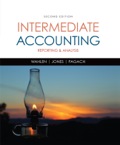
Concept explainers
1.
Prepare the
1.
Explanation of Solution
Balance sheet: This financial statement reports a company’s resources (assets) and claims of creditors (liabilities) and stockholders (
The balance sheet of company W is prepared as follows:
| Company W | |||
| Balance Sheet | |||
| December 31,2016 | |||
| Current Assets: | Amount ($) | Amount ($) | Amount ($) |
| Cash | $11,600 | ||
| Short-term investments in marketable securities [Refer to subpart 2 (note 1)] | $19,100 | ||
| $32,300 | |||
| Less: Allowance for doubtful accounts | ($1,500) | $30,800 | |
| Inventories [Refer to subpart 2 (Notes 1 and 2) ] | $98,500 | ||
| Total current assets | $160,000 | ||
| Long-Term Investments: | |||
| Investment in bonds [Refer to subpart 2 (note 1)] | $25,000 | ||
| Land held for building site | $19,500 | ||
| Cash surrender value of life insurance | $8,900 | ||
| Total long-term investments | $53,400 | ||
| Property, plant, and equipment [Refer to subpart 2 (Notes 1 and 3) ] | $229,300 | ||
| Intangible Assets: | |||
| Patents (net) [Refer to subpart 2 (Notes 1 and 2) ] | $18,200 | ||
| Total Assets | $460,900 | ||
| Liabilities | |||
| Current Liabilities: | |||
| Accounts payable | $58,000 | ||
| Income taxes payable | $24,700 | ||
| Miscellaneous current payables | $6,200 | ||
| Estimated liability for product warranties | $7,300 | ||
| Total current liabilities | $96,200 | ||
| Long-Term Liabilities: | |||
| Bonds payable (mature on 12/31/2024) | $80,000 | ||
| Premium on bonds payable | $4,800 | ||
| Total long-term liabilities | $84,800 | ||
| Total Liabilities | $181,000 | ||
| Shareholders’ Equity | |||
| Contributed Capital: | |||
| $40,000 | |||
| Common stock, $10 par, 12,000 shares authorized, 6,280 shares issued | $62,800 | ||
| Additional paid-in capital on: | |||
| Preferred stock | $23,400 | ||
| Common stock | $30,300 | ||
| Total contributed capital | $156,500 | ||
| $123,400 | |||
| Total Shareholders’ Equity | $279,900 | ||
| Total Liabilities and Shareholders’ Equity | $460,900 | ||
Table (1)
Therefore, the amount of total assets and total liabilities and stockholders’ equity equals $460,900.
2.
Prepare notes to accompany the balance sheet that itemize company accounting policies, inventories, and property, plant and equipment.
2.
Explanation of Solution
Accompanying Notes to the balance sheet:
Note (1):
Summary of important accounting policies:
- “Inventories are valued at the lower of average cost or market.”.
- “Property, plant, and equipment are recorded at cost less
accumulated depreciation . The straight-line method is used to depreciate all property, plant, and equipment, except land”. - “Patents are amortized on a straight-line basis directly to the Patent account”.
- “Temporary investments in marketable securities are stated at their market value”.
- “Investment in bonds is carried at original cost (face value) and is being held to maturity”.
Note (2):
Composition of inventories:
The inventories of the company as of December 31, 2016, are composed of the following components:
| Particulars | Amount |
| Raw materials | $22,200 |
| Work in process | $34,700 |
| Finished goods | $41,600 |
| Total | $98,500 |
Table (2)
Note (3)
Composition of property, plant, and equipment:
The property, plant, and equipment of the company as of December 31, 2016, comprise the following:
| Item | Cost | Accumulated Depreciation | Book value |
| Land | $32,000 | $32,000 | |
| Buildings | $182,400 | $62,200 | $120,000 |
| Machinery | $63,900 | $18,600 | $45,300 |
| Equipment | $53,000 | $21,200 | $31,800 |
| Total | $331,300 | $102,000 | $229,300 |
Table (3)
3.
Compute the
3.
Explanation of Solution
Current ratio: The financial ratio which evaluates the ability of a company to pay off the debt obligations which mature within one year or within completion of operating cycle is referred to as current ratio. This ratio assesses the liquidity of a company.
Quick ratio: The financial ratio which evaluates the ability of a company to pay off the instant debt obligations is referred to as quick ratio. Quick assets are cash, marketable securities, and accounts receivables. This ratio assesses the short-term liquidity of a company from its most liquid (quick) assets.
Calculate the current ratio:
Therefore, the current ratio is 1.66:4.
Compute quick ratio:
Therefore, the quick ratio is 0.64:1.
- Current ratio evaluates the
liquidity - Quick ratio analyzes a company’s potential working capital.
- Comparison of these two ratios states the amount of liquidity that comes from the inventory, which is not as liquid as the quick assets.
Want to see more full solutions like this?
Chapter 4 Solutions
EBK INTERMEDIATE ACCOUNTING: REPORTING
- I am looking for a reliable way to solve this financial accounting problem using accurate principles.arrow_forwardPlease show me how to solve this financial accounting problem using valid calculation techniques.arrow_forwardCould you help me solve this financial accounting question using appropriate calculation techniques?arrow_forward
- How can I solve this financial accounting problem using the appropriate financial process?arrow_forwardhow much overhead cost would be assigned to product G98X using the activity based costing system ?arrow_forwardThe closing price of a stock is $74.55, and the net earnings per share are $3.50. The stock's P/E ratio is .arrow_forward
 Intermediate Accounting: Reporting And AnalysisAccountingISBN:9781337788281Author:James M. Wahlen, Jefferson P. Jones, Donald PagachPublisher:Cengage Learning
Intermediate Accounting: Reporting And AnalysisAccountingISBN:9781337788281Author:James M. Wahlen, Jefferson P. Jones, Donald PagachPublisher:Cengage Learning Financial Accounting: The Impact on Decision Make...AccountingISBN:9781305654174Author:Gary A. Porter, Curtis L. NortonPublisher:Cengage Learning
Financial Accounting: The Impact on Decision Make...AccountingISBN:9781305654174Author:Gary A. Porter, Curtis L. NortonPublisher:Cengage Learning


